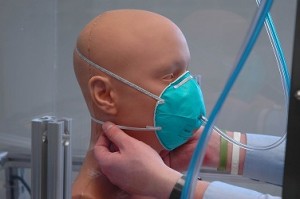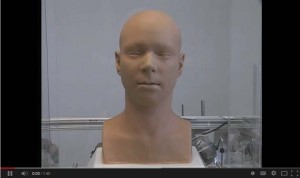Advanced Headforms for Evaluating Respirator Fit
Posted on by Over three million Americans are required to wear respirators in their workplaces. In order to strive for the highest level of protection, ongoing research is essential for learning more about the factors that affect how respirators fit to the face. As part of this pursuit, NIOSH has developed a new robotic manikin headform (called an “advanced headform”) for respirator fit evaluation research. Use of advanced headforms will greatly expand the opportunities for research into respirator inward leakage, which includes the penetration of particles through the filter itself combined with the leakage around the faceseal. This technology has the potential to aid in respirator design and contribute to the advancement of respirator certification and consensus standards.
Over three million Americans are required to wear respirators in their workplaces. In order to strive for the highest level of protection, ongoing research is essential for learning more about the factors that affect how respirators fit to the face. As part of this pursuit, NIOSH has developed a new robotic manikin headform (called an “advanced headform”) for respirator fit evaluation research. Use of advanced headforms will greatly expand the opportunities for research into respirator inward leakage, which includes the penetration of particles through the filter itself combined with the leakage around the faceseal. This technology has the potential to aid in respirator design and contribute to the advancement of respirator certification and consensus standards.
NIOSH is focusing on certified N95 filtering facepiece respirators (FFRs) for the initial fit evaluation research using the advanced headform. NIOSH-approved N95 respirators are commonly used in the healthcare industry to reduce exposure to respiratory pathogens such as influenza and Mycobacterium tuberculosis. This research is being performed in conjunction with the Air Force Research Laboratory (Panama City Beach, FL) and is funded by the Biomedical Advanced Research and Development Authority of the U.S. Department of Health and Human Services.

Click here to see a video demonstration of the headform manikin reading the rainbow passage, a common verse used in fit testing exercises.
The robotic advanced headform (built by Hanson Robotics, Inc.*) performs head movements, as well as the lip and jaw movements of speech, in order to simulate a respirator fit test. The dimensions of the robotic advanced headform were derived from a large-scale NIOSH-led study of facial measurements of U.S. respirator wearers (1, 2). NIOSH used the measurements of 3,997 individuals, 1,013 of whom had their facial measurements taken with a laser scanner, in order to create five digital headform sizes that encompass 96.4% of the sample set. The robotic advanced headform is covered in FrubberTM, which is a silicone elastomer artificial skin. Several special characteristics make FrubberTM a good simulated skin for mimicking the human face in a respirator fit evaluation:
- First, the softness of the material compares well to that of human facial tissues, as does the force required to elongate the material (3, 4);
- Second, because it is a porous material, it is able to be compressed in a similar manner as the fluid-filled cellular material of the human face, reproducing natural creases and folds;
- The robotic advanced headform also has specified tissue depths for different locations of the face.
The robotic advanced headform will be used for inward leakage research using viable biological aerosols such as H1N1 influenza. Development of the robotic advanced headform was needed for these types of studies because older type headforms (usually covered with a thin skin of plastic or rubber) could not form a good respirator seal to the face. Robotic advanced headforms can be beneficial for respirator fit evaluation research because they do not require human subject review board clearance, nor do they experience weight changes or fatigue.
The first step to implement the advanced headform into research studies is to evaluate how respirators fit on the headform compared with how they fit on people. As a preliminary study, NIOSH first developed a “medium” size static (non-robotic) headform covered in FrubberTM to determine if FrubberTM would be a good material to use for the headform. The static headform was able to achieve fit factors (a measure of respirator fit expressed as number of times exposure to aerosol particles is reduced when wearing the respirator) ≥ 100 using different N95 FFRs models and PortaCountTM fit tester(5). A preliminary evaluation of fit on N95 FFRs has been conducted utilizing human test subjects performing normal and deep breathing exercises. The same FFRs worn by the subjects were then placed on the static headform for a fit evaluation while the headform respired at the recorded breathing pattern of the person. Preliminary results show the utility of the static headform as a tool for gauging respirator fit among different FFR models(6). Research is ongoing to determine the correlation of N95 FFR fit between the robotic headform and people.
For more information on the use of Headforms in NIOSH research, please see: http://www.cdc.gov/niosh/npptl/topics/respirators/headforms/
http://www.cdc.gov/niosh/topics/anthropometry/
Michael Bergman, MS; Ziqing Zhuang, PhD; Ronald E. Shaffer, PhD
Mr. Bergman is an Associate Service Fellow in the Technology Research Branch in the NIOSH National Personal Protective Technology Laboratory
Dr. Zhuang is the Respiratory Protection Research Team Leader in the Technology Research Branch in the NIOSH National Personal Protective Technology Laboratory (NPPTL).
Dr. Shaffer is a Senior Scientist in the Office of the Director of NIOSH’s National Personal Protective Technology Laboratory
*References to products or services do not constitute an endorsement by NIOSH or the U.S. government.
References
- Zhuang, Z.Q., B. Bradtmiller, and R.E. Shaffer: New respirator fit test panels representing the current US civilian work force. Journal of Occupational and Environmental Hygiene 4(9): 647-659 (2007).
- Zhuang, Z., S. Benson, and D. Viscusi: Digital 3-D headforms with facial features representative of the current US workforce. Ergonomics 53(5): 661-671 (2010).
- Hanson, D., R. Bergs, Y. Tadesse, V. White, and S. Priya: Enhancement of EAP Actuated Facial Expressions by Designed Chamber Geometry in Elastomers. Proc. SPIE’s Electroactive Polymer Actuators and Devices Conf., 10th Smart Structures and Materials Symposium, San Diego(2006).
- Hanson, D., and V. White: Converging the Capabilities of ElectroActive Polymer Artificial Muscles and the Requirements of Bio-inspired Robotics. Smart Structures and Materials 2004: Electroactive Polymer Actuators and Devices (EAPAD), edited by Yoseph Bar-Cohen, Proceedings of SPIE Vol. 5385 (SPIE, Bellingham, WA), 2004.
- Bergman, M., Z. Zhuang, R.J. Wande, D. Hanson, B. Heimbuch, M. McDonald et al.: Development of an Advanced Respirator Fit Test Headform. Journal of Occupational and Environmental Hygiene In Press(2013).
- Zhuang, Z., M. Bergman, M. Joseph, and R. Shaffe: Human Correlation Fit Testing of a Static Advanced Headform. Presentation at the NPPTLStakeholder Meeting on Respiratory Protection for Healthcare Workers, Atlanta, GA June 18, 2013 (2013).
3 comments on “Advanced Headforms for Evaluating Respirator Fit”
Comments listed below are posted by individuals not associated with CDC, unless otherwise stated. These comments do not represent the official views of CDC, and CDC does not guarantee that any information posted by individuals on this site is correct, and disclaims any liability for any loss or damage resulting from reliance on any such information. Read more about our comment policy ».


doese this headform work with a military gas mask for leakage test ?
We have not conducted any research so far to determine whether the static or articulated headform could be used for leakage tests with military gas masks, but it is something worth considering in a future study. There are commercial products available for this purpose.
Really cool submit, highly educational and quality..Good Task
harrison